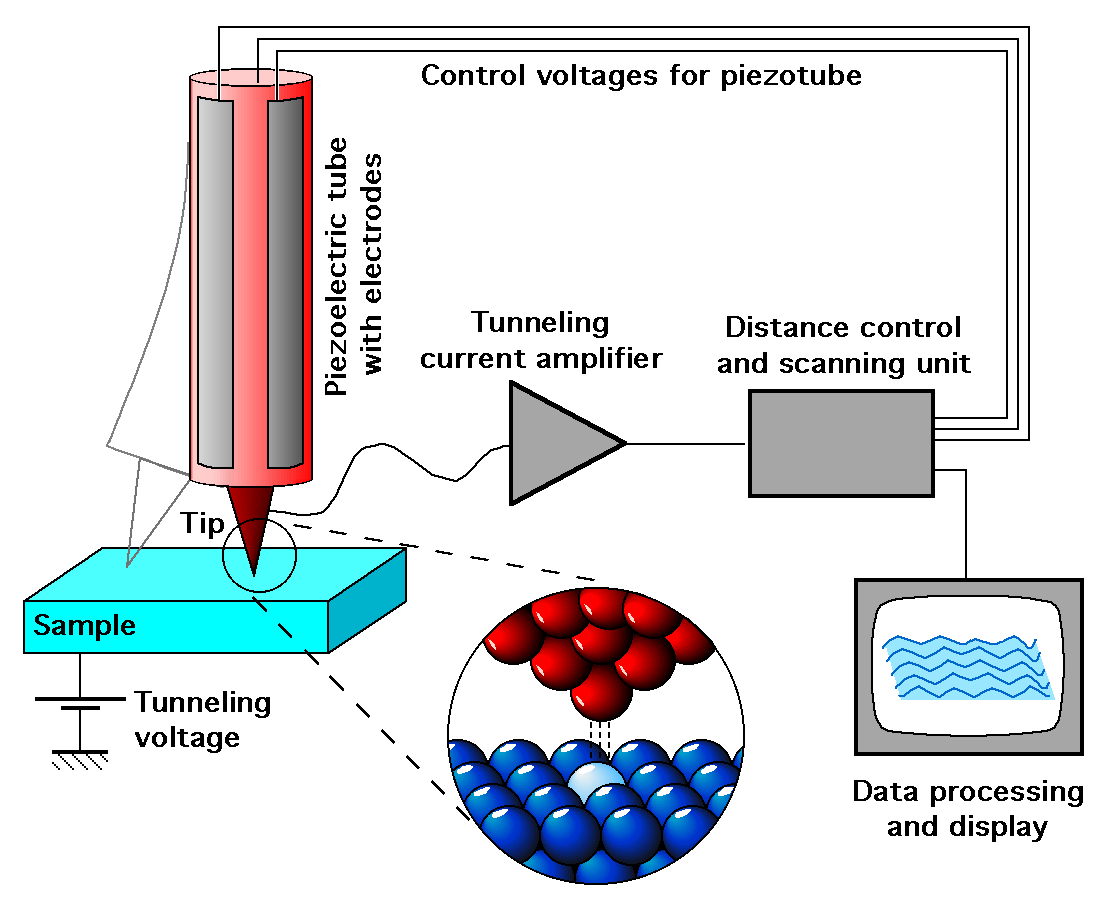Most of
the time, the sciences and arts are categorized as visual experiences.
Scientists need to see proof from their experiments, whereas artists have to
interpret artworks and performances visually. However, this week’s lectures
have shown that nanotechnology is changing this perception by introducing a new
medium that cannot be seen with the naked eye.




A scanning tunneling microscope such as the one pictured gives people a look into the nanoscopic universe[1][2].
Although
the idea of nanotechnology may have been thought of by Richard Feyman in 1959[1],
the real geniuses who brought this small world into reality are Gerd Binnig and
Heinrich Rohrer. Their scanning tunneling microscope (STM) uses touch rather
than sight in order to detect atomic structures[2]. In many ways,
this duo can be credited for the revolution of nanotechnology. With this
microscope alone, a new world opened up for scientists and artists alike. As
Vesna and Gimzewski perfectly describe it, the STM is a “paradigm shift from seeing,
When
hearing about the STM in lecture, I instantly remembered a movie called A Boy and His Atom: The World’s Smallest
Movie that my electrical engineering professor showed me last year. Before
this time, I did not even realize that the experience of “seeing” atoms was
possible. In this movie, though, real atoms are moved around using a STM to
create fluid images of a boy doing various activities[4]. Even
though the images are childish at best, the fact that art is being made out of
atoms is truly remarkable. It is even more astounding when one realizes that
these atoms are not being seen in the typical sense. This brings the experience
to whole another level, giving an illusion that atoms can be easily manipulated
by human beings. Similar to the boy in the movie being able to do just about
anything, the real message from this movie is showing that there are endless
possibilities when it comes to nanotechnology.
A team at IBM made this short video with atoms[3].
Innovation
with nanotechnology does not just stop with art. It can also be used in the
field of medicine. From quantum dots that locate diseases to nanotubes that
kill tumors[5][6], nanotechnology is a driving force behind better
treatments for patients. However, like all nanotechnology, it cannot be seen in
a physical sense. This might be actually more beneficial since it makes these
type of instruments less intrusive. Rather than having a hulking machine harm
the body, nanotechnologies can seamlessly blend in with the body’s natural
composition of cells and proteins. This natural change associated with
nanotechnology can be the key to curing all sorts of difficult diseases like cancer.

A digital image showing how nanotechnology can be used to treat diseases[4].
In
summary, the arrival of the STM in nanotechnology made it possible for new advancements
in the arts and medicine. Despite the fact that these innovations may never be
physically looked at, their impact can still resonate within a person’s body
and mind. Sometimes, the true beauty of art and science lies in what is unseen
rather than what is seen.
Sources:
1. Gimzewski, James K. "Introduction to Nanotechnology for Artists: Part 1." YouTube. uconlineprogram, 21 May 2012. Web. 20 July 2016. <https://www.youtube.com/watch?v=q7jM6-iqzzE>.
2. Gimzewski, James K. "Introduction to Nanotechnology for Artists: Part 2." YouTube. uconlineprogram, 21 May 2012. Web. 20 July 2016. <https://www.youtube.com/watch?v=HEp6t0v-v9c>.
3. Gimzewski, Jim, and Victoria Vesna. "The Nanomeme Syndrome: Blurring of Fact & Fiction in the Construction of a New Science." Victoria Vesna. N.p., n.d. Web. 20 July 2016. <http://vv.arts.ucla.edu/publications/publications/02-03/JV_nano/JV_nano_artF5VG.htm>.
4. A Boy And His Atom: The World's Smallest Movie. YouTube. IBM, 30 Apr. 2013. Web. 20 July 2016. <https://www.youtube.com/watch?v=oSCX78-8-q0>.
5. Gimzewski, James K. "Introduction to Nanotechnology for Artists: Part 4." YouTube. uconlineprogram, 21 May 2012. Web. 20 July 2016. <https://www.youtube.com/watch?v=yHCuZetAIhk>.
6. "Nanotechnology in Medicine - Nanomedicine." Understandingnano.com. Hawk's Perch Technical Writing LLC, n.d. Web. 20 July 2016.
Images/Videos:
1. UTA NanoFab. The Scanning Tunneling Microscope. N.d. IBM 100. IBM. Web. 21 July 2016. <http://www-03.ibm.com/ibm/history/ibm100/us/en/icons/microscope/>.
2. Schematic View of an STM. Digital image. Wikipedia. Wikimedia Foundation Inc., n.d. Web. 21 July 2016. <https://en.wikipedia.org/wiki/Scanning_tunneling_microscope>.
3. A Boy And His Atom: The World's Smallest Movie. YouTube. IBM, 30 Apr. 2013. Web. 21 July 2016. <https://www.youtube.com/watch?v=oSCX78-8-q0>.
4. Murray, James J. Nanoparticles to Cure - And to Kill! Digital image. Prescription for Murder. N.p., 28 Jan. 2015. Web. 21 July 2016. <https://jamesjmurray.wordpress.com/2015/01/28/nanoparticles-to-cure-and-to-kill/>.
Sources:
1. Gimzewski, James K. "Introduction to Nanotechnology for Artists: Part 1." YouTube. uconlineprogram, 21 May 2012. Web. 20 July 2016. <https://www.youtube.com/watch?v=q7jM6-iqzzE>.
2. Gimzewski, James K. "Introduction to Nanotechnology for Artists: Part 2." YouTube. uconlineprogram, 21 May 2012. Web. 20 July 2016. <https://www.youtube.com/watch?v=HEp6t0v-v9c>.
3. Gimzewski, Jim, and Victoria Vesna. "The Nanomeme Syndrome: Blurring of Fact & Fiction in the Construction of a New Science." Victoria Vesna. N.p., n.d. Web. 20 July 2016. <http://vv.arts.ucla.edu/publications/publications/02-03/JV_nano/JV_nano_artF5VG.htm>.
4. A Boy And His Atom: The World's Smallest Movie. YouTube. IBM, 30 Apr. 2013. Web. 20 July 2016. <https://www.youtube.com/watch?v=oSCX78-8-q0>.
5. Gimzewski, James K. "Introduction to Nanotechnology for Artists: Part 4." YouTube. uconlineprogram, 21 May 2012. Web. 20 July 2016. <https://www.youtube.com/watch?v=yHCuZetAIhk>.
6. "Nanotechnology in Medicine - Nanomedicine." Understandingnano.com. Hawk's Perch Technical Writing LLC, n.d. Web. 20 July 2016.
Images/Videos:
1. UTA NanoFab. The Scanning Tunneling Microscope. N.d. IBM 100. IBM. Web. 21 July 2016. <http://www-03.ibm.com/ibm/history/ibm100/us/en/icons/microscope/>.
2. Schematic View of an STM. Digital image. Wikipedia. Wikimedia Foundation Inc., n.d. Web. 21 July 2016. <https://en.wikipedia.org/wiki/Scanning_tunneling_microscope>.
3. A Boy And His Atom: The World's Smallest Movie. YouTube. IBM, 30 Apr. 2013. Web. 21 July 2016. <https://www.youtube.com/watch?v=oSCX78-8-q0>.
4. Murray, James J. Nanoparticles to Cure - And to Kill! Digital image. Prescription for Murder. N.p., 28 Jan. 2015. Web. 21 July 2016. <https://jamesjmurray.wordpress.com/2015/01/28/nanoparticles-to-cure-and-to-kill/>.
No comments:
Post a Comment